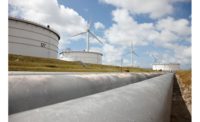The Colonel Smith Middle School in southern Arizona intends to preach what it practices. Built on Fort Huachuca, the U.S. Army's leading intelligence-training post about 90 miles southeast of Tucson, the $22-million school will demonstrate sustainability to students and the surrounding community. It will also likely become Arizona's first—and the nation's 12th—net-zero energy use school.
The Phoenix office of construction manager-at-risk Turner Construction Co. expects to deliver the one-level, 88,700-sq-ft building on schedule by the first week of August. Approximately 375 sixth- to eighth-grade students within the Fort Huachuca Accommodation School District will begin using its sustainable and educational features at the start of the fall 2012 semester, just one year after the project broke ground.
To achieve net-zero certification, a building must annually generate on site as much or more energy than it consumes. "We will begin monitoring at turnover of the building to the owner, then do verifications at 90 days, 120 days and one year," says Tony Wall, president of Mesa, Ariz.-based 3W Management and the owner's representative and program manager.
Universally accepted certification does not exist, although in October 2011 the International Living Future Institute in Portland, Ore., established a program for Net Zero Energy Building Certification that developed out of its Living Building Challenge.
"Our team is working with ILFI on a number of areas of performance and recognition for our project, and we expect to achieve net-zero certification from them after 12 months of operation," Wall says.
The middle school will also be a living lab, using the structure as a teaching tool while applying STEM (science, technology, engineering and mathematics) curriculum. A central energy dashboard will monitor the school's energy and environmental functions and send this information to students' iPads. The students will follow data such as plug loads and will essentially serve as energy police, watching for anomalies. In addition, at the research center on the campus they will learn about school conservation methods.
To ensure that the school's design and construction were commensurate with its sustainable mission, Mesa, Ariz.-based architect-of-record Emc2 Group and consulting architect Fanning Howey Architects, Indianapolis, completely rethought traditional design paradigms for educational buildings.
"When we started to look at strategies to open up spaces, introduce the outdoors into the classroom and provide flexible spaces, it became clear that lighting, HVAC and materials had to be high performance to meet the project requirements," says Richard J. Clutter, Emc2 Group's president.
Furthering the educative function, the design and construction team placed green components such as solar panels, HVAC units and three wind turbines at ground level, rather than hiding them away from view as in traditional buildings.
Net zero is most easily and most economically achieved combining many strategies, says Michael Deane, Turner's vice president and chief sustainability officer. "The first and most important strategy is using good traditional design to maximize the efficiency of the building envelope—be sensitive to site conditions (wind, light, thermal massing, solar orientation and others) before thinking about onsite renewable energy generation," Deane says. "By reducing demand, you can reduce the cost and technology burden of providing power."











Post a comment to this article
Report Abusive Comment